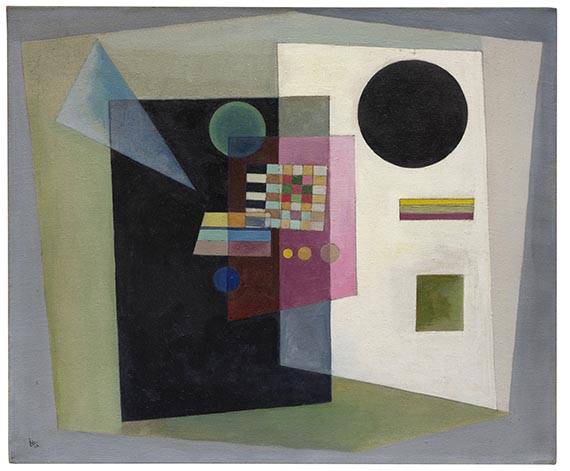Dictionary


Spiritual-mental Abstraction before 1945: Kandinsky and related artists
At the beginning of the 20th century, there was an increasing tendency to move away from objectivity and towards abstraction, and assign colours and forms autonomous value. This tendency can be divided into two main strands - one was rational, geometric abstraction, and the other spiritual-psychological abstraction. The key exponent of spiritual-psychological abstraction was Wassily Kandinsky (1866-1944).
In his essay "Concerning the Spiritual in Art" (1911), Kandinsky stated his position on non-objective art. In the essay, he described form and colour as expressions of internal life and claimed: "Form alone, even though totally abstract and geometrical, has a power of inner suggestion, and is a living being with qualities that are identical with this form". Around the same time that he composed these spiritual reflections on abstract art, Kandinsky completed his move towards artistic abstraction in his work. The "First Abstract Watercolour" (1910) and a large number of his graphic works were characterised by abstraction.
Spiritual content, sometimes of religious or lyrical nature, entered Kandinsky’s work in abstract form. This formal vocabulary thus functioned as a visual metaphor and was meant to trigger associations and activate spiritual power in the beholder.
Also relevant to the understanding of Kandinsky’s spiritual-psychological abstraction was the artist’s focus on the effects of synaesthetic processes, and important inspiration from Theosophical-mystical worldviews.
His meeting with Marianne von Werefkin (1870-1938) was also productive, as it is believed that it was Kandinsky’s partner, who gave him the impetus to move towards abstraction. Gabriele Münter, August Macke and Franz Marc were also amongst the artists who freed themselves from objective, illustrative representation in order to increase their focus on pure colour and form. Franz Marc (1860-1916) divided colour values into categories, as described in a letter to August Macke in 1910, in which he associated blue with male, harsh, and spiritual qualities, and yellow with the gentle, joyous principles of woman.
At the beginning of the 20th century, there was an increasing tendency to move away from objectivity and towards abstraction, and assign colours and forms autonomous value. This tendency can be divided into two main strands - one was rational, geometric abstraction, and the other spiritual-psychological abstraction. The key exponent of spiritual-psychological abstraction was Wassily Kandinsky (1866-1944).
In his essay "Concerning the Spiritual in Art" (1911), Kandinsky stated his position on non-objective art. In the essay, he described form and colour as expressions of internal life and claimed: "Form alone, even though totally abstract and geometrical, has a power of inner suggestion, and is a living being with qualities that are identical with this form". Around the same time that he composed these spiritual reflections on abstract art, Kandinsky completed his move towards artistic abstraction in his work. The "First Abstract Watercolour" (1910) and a large number of his graphic works were characterised by abstraction.
Spiritual content, sometimes of religious or lyrical nature, entered Kandinsky’s work in abstract form. This formal vocabulary thus functioned as a visual metaphor and was meant to trigger associations and activate spiritual power in the beholder.
Also relevant to the understanding of Kandinsky’s spiritual-psychological abstraction was the artist’s focus on the effects of synaesthetic processes, and important inspiration from Theosophical-mystical worldviews.
His meeting with Marianne von Werefkin (1870-1938) was also productive, as it is believed that it was Kandinsky’s partner, who gave him the impetus to move towards abstraction. Gabriele Münter, August Macke and Franz Marc were also amongst the artists who freed themselves from objective, illustrative representation in order to increase their focus on pure colour and form. Franz Marc (1860-1916) divided colour values into categories, as described in a letter to August Macke in 1910, in which he associated blue with male, harsh, and spiritual qualities, and yellow with the gentle, joyous principles of woman.
Offers for Modern Abstract Art
Headquarters
Joseph-Wild-Str. 18
81829 Munich
Phone: +49 89 55 244-0
Fax: +49 89 55 244-177
info@kettererkunst.de
Louisa von Saucken / Undine Schleifer
Holstenwall 5
20355 Hamburg
Phone: +49 40 37 49 61-0
Fax: +49 40 37 49 61-66
infohamburg@kettererkunst.de
Dr. Simone Wiechers / Nane Schlage
Fasanenstr. 70
10719 Berlin
Phone: +49 30 88 67 53-63
Fax: +49 30 88 67 56-43
infoberlin@kettererkunst.de
Cordula Lichtenberg
Gertrudenstraße 24-28
50667 Cologne
Phone: +49 221 510 908-15
infokoeln@kettererkunst.de
Hessen
Rhineland-Palatinate
Miriam Heß
Phone: +49 62 21 58 80-038
Fax: +49 62 21 58 80-595
infoheidelberg@kettererkunst.de
We will inform you in time.




